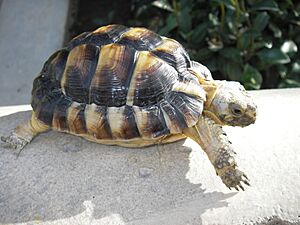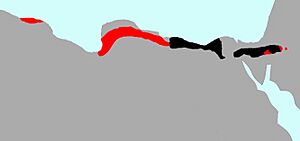Kleinmann's tortoise facts for kids
Quick facts for kids Kleinmann's tortoise |
|
|---|---|
 |
|
| Five-year-old specimen of Kleinmann's tortoise | |
| Conservation status | |
| Scientific classification | |
| Genus: |
Testudo
|
| Species: |
kleinmanni
|
 |
|
| Range map of the Egyptian tortoise; red color indicates remaining range, and black indicates extinct range | |
| Synonyms | |
|
|
The Kleinmann's tortoise (Testudo kleinmanni) is also known as the Egyptian tortoise. It is a very small tortoise. This species is critically endangered, which means it is at a very high risk of disappearing forever.
These tortoises live in Egypt, Libya, and Israel. They used to be found in many more places. Sadly, their numbers are now very low. They are almost gone from Egypt. Without more help, they could become extinct in the wild.
Contents
Naming the Kleinmann's Tortoise
The scientific name, kleinmanni, honors Edouard Kleinmann. He was a French stockbroker who found the first tortoise of this type in 1875.
Another name, werneri, was given to a tortoise once thought to be a different species. This name honored Israeli scientist Yehudah L. Werner.
What Does the Egyptian Tortoise Look Like?
The Kleinmann's tortoise is the smallest tortoise in the northern part of the world. Female tortoises are usually bigger than males. Males are thinner and have longer tails.
Their shell, called a carapace, is shaped like a high dome. It can be many colors, from light ivory to pale gold, dark brown, pink, or dull yellow. The shell can be up to 14.4 cm long. These colors help the tortoise survive in the desert. Lighter colors help them stay cooler in the sun. The colors also help them blend in with their surroundings.
The bottom part of their shell, called the plastron, is light yellow. It often has two dark triangles on each scute (the plates that make up the shell). The edges of these scutes are dark when the tortoise is young, but they fade as it gets older.
Their head and legs are a very light yellowish-white or yellowish-brown color.
How Scientists Classify Them
Scientists once thought a group of these tortoises, called the "Negev tortoise" (Testudo werneri), was a separate species. However, after studying their DNA, scientists found they were the same as the Kleinmann's tortoise. This means T. werneri is now considered the same species as T. kleinmanni.
Where They Live and What They Do
Kleinmann's tortoises live in deserts and dry areas. They prefer places with sand, gravel, scattered rocks, and dry riverbeds. They can also be found in shrubby areas and coastal salt marshes.
In zoos, they eat grasses, fruits, and vegetables. However, we don't know exactly what they eat in the wild. These tortoises tend to live in places that get very little rain, less than 50 mm each year. This includes large desert areas in countries like Egypt and Libya.
They are not very active when the weather is extremely cold or hot. In colder months, they are most active around midday. In warmer seasons, they are active in the mornings and evenings. The rest of the day, they hide under bushes or in rodent burrows to stay safe and cool.
Reproduction and Life Cycle
Kleinmann's tortoises can start having babies when they are about 5 years old. In the wild, they have been seen mating in March. In zoos, they mate in April and from August to November.
During courtship, the male tortoise will bump into the female and sometimes chase her. Unlike other Mediterranean tortoises, the Kleinmann's tortoise might make a sound like a mourning dove during mating.
They lay their eggs in shallow nests under bushes or in empty burrows. Each time, a female lays one to five eggs. The baby tortoises hatch in the summer or early autumn.
Status and Conservation Efforts
The Kleinmann's tortoise used to live in Egypt, Libya, and Israel. Sadly, their homes in Egypt have been almost completely destroyed. The Egyptian tortoise is now very close to disappearing there. In 2006, only about 10 wild tortoises were known near Lake Bardawil.
Two groups of these tortoises can still be found in Libya. But much of their coastal home has been ruined by human activities. Losing their homes and the illegal pet trade are huge problems for this species. People also hunt them for use in traditional medicine.
Their numbers are still going down. The risk of them becoming extinct in the wild is very real. This will happen if their homes keep being destroyed and if the illegal trade continues.
In Israel, Kleinmann's tortoises live in the northwestern Negev desert. They are protected by law. Several programs are trying to help them, like creating new protected areas. However, they are still in danger from farms, too much animal grazing, and new buildings on the sand dunes. In 2010, there were fewer than 2,000 tortoises left in Israel.
The IUCN Red List calls the Kleinmann's tortoise "critically endangered". This is the highest risk category before extinction in the wild. Not long ago, there were about 55,000 to 56,000 adult tortoises. Today, only about 7,500 remain. Their numbers are still dropping because their homes are being destroyed and people are illegally taking them.
Scientists believe the illegal pet trade might have reduced the population to only about 1,000 adult tortoises in the few remaining groups. Since these tortoises grow slowly, live a long time, and have few babies, this small number might not be enough for the species to survive in the wild. There are plans to release tortoises from breeding centers in Israel to help the wild population, but these plans need to be approved.
It is important not to mix tortoises from different areas for reintroduction. This is because their natural homes have different conditions. Scientists can use DNA fingerprinting to help keep the captive populations healthy and diverse.
Breeding these tortoises in zoos needs more care than other tortoise species. They are more delicate, and they lay very few eggs. However, experienced tortoise breeders can do it. It is usually not legal for people to keep Kleinmann's tortoises as pets. Even if it were legal, it's best to avoid them without proper documents. Smuggling is still a problem. But tortoises that are rescued from smugglers are used to start safe populations in zoos.
On May 21, 2007, the Bioparco zoo in Rome announced they successfully bred the species. The parent tortoises were rescued from a smuggler in 2005. Other zoos in Europe and North America also keep and breed them.
-
A group of Kleinmann's tortoises found in a shipment from Libya, meant for the illegal pet market, in Genoa, 2005.
Threats to the Kleinmann's Tortoise
The Kleinmann's tortoise faces many dangers caused by humans. These include farming, too much animal grazing, building new developments, and especially the illegal pet trade. When the tortoises in Egypt almost disappeared, people started taking tortoises from Libya for the pet market. This practice later became illegal.
Farming, overgrazing by animals, and new buildings all destroy the tortoise's natural home. These problems make it harder for the species to survive.
The illegal pet trade is a very serious threat. It started when tortoises were taken from Libya after the Egyptian populations were almost gone. This illegal trade continues in Egypt and Libya. It can have terrible effects on the total number of tortoises in the world. It seems that more tortoises are being taken from the eastern regions.
The Kleinmann's tortoise is very sensitive to changes in its population. This is because it produces very few offspring each year. It also struggles to recover if its population numbers drop.









